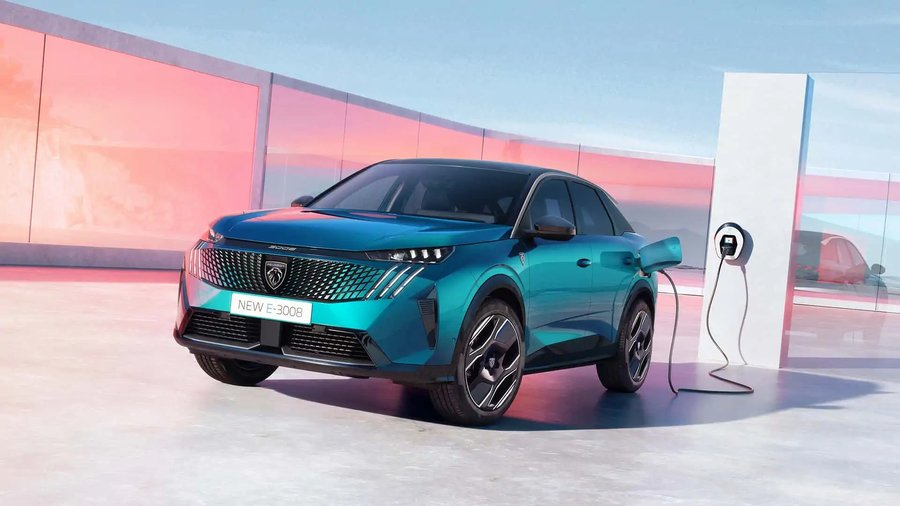Peugeot e-3008 pairs bold redesign with 435-mile range

This is the all-new Peugeot e-3008, the French brand’s first model based on a radical new Stellantis architecture that will underpin up to two million cars per year.
Building on the huge success of today’s second-generation 3008, which made a switch in bodystyle from the first generation, the new e-3008 takes on a bold fastback design inspired by the recent Peugeot 408.
The e-3008 is one of five new Peugeot EVs that will be launched between now and the end of 2024. It will be joined by new electric versions of the 308 and 308 SW, an electric 408 and an all-new e-5008.
The new 5008 will be moved further away in style and purpose from the current model to provide greater distance to the e-3008.
The larger car will put greater focus on its spacious family credentials, and the e-3008 will be Peugeot’s more stylish and dynamic offering in the C-segment crossover class. The e-3008 “is the start of our C-segment offensive”, Peugeot product boss Jérôme Micheron told Autocar.
“The growth of the EV market is in the C-segment and this is a focused offensive on top of our success in the B-segment [with the e-208 and e-2008].”
The new STLA Medium 400V architecture on which it is based (see box, right) is designed primarily for EVs but can accommodate hybrid and PHEV powertrains, both of which will be added to the new 3008 line-up in time.
STLA Medium is natively front-wheel drive and the standard single-motor version of the e-3008 produces 207bhp and 251lb ft for 0-62mph in 8.7sec and a top speed of 106mph.
Peugeot claims a range of 326 miles from the model’s 73kWh (usable capacity) battery. A Long Range version ups power to 227bhp and touts a 435-mile range courtesy of its larger, 98kWh battery, the biggest that will be offered on STLA Medium models. Peugeot will also offer a dual motor version for four-wheel drive with a combined output of 316bhp and a 326-mile range.
This model can go from 0-62mph in 6.4sec. Great focus has been placed on making the e-3008 as efficient as it can be, through not only aerodynamic work that allows for a drag coefficient of 0.28 but also a new heat pump, cooling system, steering, tyres and friction-reducing bearings.
The result is that Peugeot’s new crossover claims best-in-class efficiency of 4.5 miles per kWh for the entry-level version. The maximum charging speed of the e-3008 is 160kW, giving a 20-80% charge in 30 minutes and a charging rate of 2.4kWh per minute at its peak.
The new e-3008 is marginally larger than the car it replaces, at 4542mm long, 1895mm wide and 1641mm wide, with a wheelbase of 2739mm. But the new proportions with shortened overhangs and the coupé-esque roof make the e-3008 appear more compact than it actually is.
It weighs from 2114kg in entry-level form, around 500kg of which comes from the battery pack. A raft of new design flourishes rounds off the visual transformation, including an evolution of Peugeot’s three-light signature at the front and rear, the 3008 model name displayed on the front, internally mounted window seals on the glasshouse and a floating spoiler at the rear.
Inside, the latest version of Peugeot’s i-Cockpit introduces a 21in curved LED screen for higher-trim cars that doubles as a driver display and central infotainment.
As standard, the e-3008 gets two separate 10in displays. The new-look steering wheel hosts a revised array of physical controls, and on the centre console is a row of 10 customisable shortcut touchscreen buttons called ‘i-Toggles’, which can be tailored to very specific functions – such as reserving one for calling a specific person on your phone.
No chrome is used anywhere on the car, with the trim inside mixing fabrics and aluminium. The new suspension promises a blend of comfort and “dynamic roadholding”.
There are three stages of regenerative braking and three different driving modes – Eco, Normal and Sport – with a fourth 4WD mode added on twin-motor versions, which Stellantis says works for full off-road applications. Two trim levels will be offered – Allure and GT – and Peugeot expects a 60:40 sales split between the two.
Allure gets 19in alloys and GT 20in alloys as well as the 21in screen for the interior and Alcantara seats – and each trim can be specified with a choice of three option packs. The new e-3008 – built again in Sochaux, France – will go on sale in November, when prices will be announced ahead of UK deliveries in February 2024.
Q&A with Matthias Hossann, Peugeot design director
How did you look to evolve the new 3008 from today’s?
“The second-generation 3008 still looks good but the switch to EV changed our thinking. We have the fastback silhouette; we surveyed our customers and this silhouette is attractive to them. An SUV silhouette is challenging with EVs, and this silhouette is based on what we started with the 408. It’s good for efficiency and helps with engineering challenges.”
Is it hard to replace a car that’s been so successful?
“It’s difficult to replace successful cars and sometimes you can look to not change anything. That would be a risk, so we rethought the car again from scratch, but there are some reminders [to the current 3008] in some of the details.”
Did you draw inspiration from the Inception concept?
“When you do a concept car, it’s a laboratory for new designs and experiences. We started e-3008 before Inception but they have plenty in common: sleek and with a simple design language and with common light signatures. We reinvented the i-Cockpit too. Inception shows the next-generation EV design direction and this is the first of those cars.
“There’s also the Quartz concept car of 2014, the first car I worked on at Peugeot. It was a fastback and dynamic, and it shows how concept cars can influence production cars over time.”
